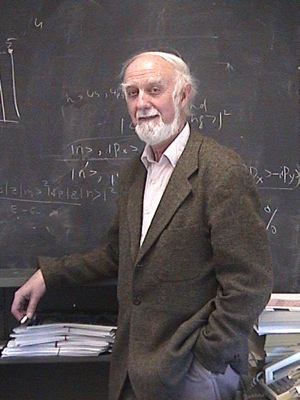
Symposium for Franklin laureate
Harvard molecular astrophysics pioneer to be honored
9:54 a.m., April 19, 2013--The University of Delaware will host the symposium “Molecules in Space” in honor of Alexander Dalgarno, recipient of the 2013 Benjamin Franklin Medal in Physics, from 2-4:50 p.m. Wednesday, April 24, Trabant University Center Theatre. The event is free and open to the public.
Dalgarno, the Phillips Professor of Astronomy at Harvard University, will receive the medal for his contributions to the field of molecular astrophysics, which led to a better understanding of interstellar space including giant molecular clouds, the dense, cold regions where stars and planets are born.
Research Stories
Chronic wounds
Prof. Heck's legacy
Krzysztof Szalewicz, professor in the Department of Physics and Astronomy at UD and a member of the Franklin Institute's Committee on Science and the Arts, organized the symposium in Dalgarno’s honor. Szalewicz prepared the case report about Dalgarno’s scientific contributions, upon which the award selection was based, and provides the description below.
Speakers at the symposium include the following:
- David Neufield, from Johns Hopkins University, will present “Small Interstellar Molecules and What They Tell Us.”
- Eric Herbst, from the University of Virginia, will speak on “Organic Molecules in Star-Forming Regions.”
- Tom Hartquist, from the University of Leeds, will talk about “Molecules in Astrophysical Accretion — From Protoplanetary Discs to Clusters in Galaxies.”
- Dalgarno, the Franklin laureate, will deliver “The Growth of Molecular Complexity in the Universe.”
Franklin laureates are selected from candidates from all over the world in the fields of chemistry, computer and cognitive sciences, earth and environmental science, engineering, life science and physics. The laureates are brought to Philadelphia each April for a weeklong series of events and activities aimed at connecting and celebrating their accomplishments with area students and the community.
The awards, founded at the institute’s beginning in 1824, are recognized among the oldest and most prestigious science and technology honors in the world, with winners recognized for their groundbreaking contributions to science.
About Dalgarno’s work
As Szalewicz explains, Dalgarno began developing molecular physics into a rigorous field of scientific investigation beginning in the 1960s. Molecular physics uses atomic and molecular spectra from astronomical observations to model all regions of interstellar space (the space between stars in a galaxy or between galaxies) that have significant densities of matter.
This matter, called the interstellar medium, consists of atomic and molecular gas (largely ionized) and dust grains (1 percent). The latter are micrometer-size particles built of various minerals and of ice. The most ubiquitous atoms are hydrogen, 89 percent, and helium, 9 percent. More than 100 molecules have been detected in interstellar space, up to 10 atomic ones.
Molecular clouds are regions of interstellar space with a higher density of matter than other regions. However, the highest-density is only 106 atoms/cm3 (for comparison, in liquid water there are 1022 atoms/cm3). Although this density is so low, the so-called giant molecular clouds have masses 103-107 times the mass of the sun.
Molecular clouds are the regions where stars and planets form when dense fragments of such clouds collapse under gravity. Thus, one of the primary fields of study of molecular astrophysics is star and planet formation. Molecules are found in space mostly in cool astrophysical environments such as molecular clouds, but also in many other environments, from stellar atmospheres to those of planetary satellites.
Molecules are excited to various electronic and rovibrational energy levels by collisions with other molecules, atoms, and electrons or by absorbing a photon, and later fall back to lower energy levels emitting a photon. High-energy radiation, such as ultraviolet light or X-rays, can also break the molecular bonds which hold atoms in molecules.
In cool environments, molecular radiation is most easily studied via detection of photons emitted when the molecules make transitions between low rotational energy states. For example, one important molecule in interstellar space, carbon monoxide, emits a photon of 2.6 mm wavelength when it falls from its lowest excited state to its ground state. This frequency is a thousand times higher than typical FM radio frequencies but more than a thousand times lower than that of visible light. Because of the dusty environment of molecular clouds, visible light cannot get out, but millimeter and far-infrared radiation does reach Earth.








